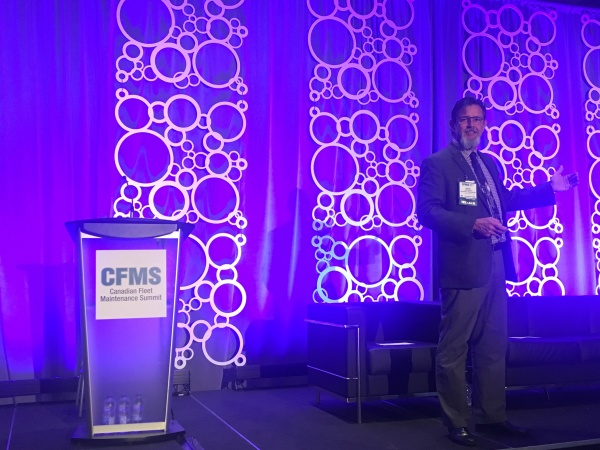Get with the times
MISSISSAUGA, Ont. – Want to be successful in safety and maintenance? Then get with the times.

That was the message from Mike Jeffress, the v.p. of maintenance of Little Rock, Arka.’s Maverick Transportation at this year’s Canadian Fleet Maintenance Summit on April 18.
Jeffress has been in the maintenance side of trucking for more than three decades and shared his experiences of what he’s learned about the evolution of fleet maintenance with attendees.
The 80s
In 1986, Maverick has 12 company trucks and 30 owner-operators.
Back then, Jeffress said, there were maybe a handful of sensors on the trucks, so technicians didn’t need to have a whole lot of education to be successful.
“A technician in the 80s needed a good fundamental of preventive maintenance,” he said. “Our schedule was simply based off miles, and as we know, that’s changed dramatically from what we have today. In the 80s, you didn’t need a tech with good problem-solving skills or critical thinking. He needed to know repetitive kind of repairs. It was a basic job function.”
Jeffress added that in that decade, a good driver would get 5.5 miles per gallon and maintenance intervals were around 10-12,000 miles.
The 90s
The 90s are when the first emissions regulations came into play, Jeffress said. It was during this time that the role of the technician changed.
“They were more technically advanced individuals,” he said. “They got out of their comfort zone and were not scared of computers.”
The 90s were also a time when Jeffress said mentoring was critical.
“And it wasn’t older gentlemen teaching the younger guys,” he said. “It was the younger guys teaching the older guys not to be afraid of the computers.”
In the 90s, maintenance intervals were 17-20,000 miles.
The 2000s
“From 2000-2010, this is when things really changed,” Jeffress said. “Which made things interesting but complicated.”
In the 2000s, emissions changed again and now, technicians had a wide knowledge of sensors.
On top of this, for Maverick, in 2002 is when safety came into a real focus.
“In 2002 we implemented collision mitigation systems to help out drivers make better decisions,” he said. “We also incorporated lane departure warning systems, to let our drivers know when he/she was drifting out of his/her lane. Safety technology is critical and if you have to be supporting this technology from a maintenance standpoint.”
Jeffress said Maverick is a big believer in safety and pushes those technologies daily. Since 2002, Maverick has spent US$3.5 million on repairing safety technology.
“And that’s a big number…because you can either be part of the problem, or part of the solution,” he said.
Today
Today, Maverick boasts 1700 power units and 2400 trailers. Its average maintenance interval cycle is 70,000 miles and its drivers average 8 mpg.
Jeffress said that in the next 5-10 years he anticipates “an explosion” of trailer technology, so he is gearing up to having coding sequences to help him manage this incoming technology, because he knows “we’re not in the 80s anymore.”
As far as his 120 technicians go, Jeffress said he is focusing on ongoing training.
In the last few years, Jeffress said he would notice when an electrical or rare problem would come into the shop for repairs, some technicians would freeze up and get intimidated.
“Because they were so used to doing those repetitive repairs,” he said. “And if they don’t use it, they lose it.”
To help his techs become more confident in their abilities, Jeffress said he has revamped his technician training program.
“So every guy gets one hour a week, reviewing a problem they won’t regularly see in electrics,” he said. “And we coach and train and teach them…so when they get it once in a blue moon, they have the confidence they need. I’m really investing in my individuals.”
Have your say
This is a moderated forum. Comments will no longer be published unless they are accompanied by a first and last name and a verifiable email address. (Today's Trucking will not publish or share the email address.) Profane language and content deemed to be libelous, racist, or threatening in nature will not be published under any circumstances.